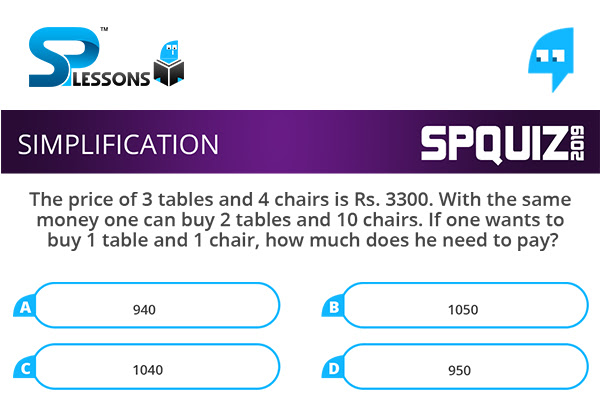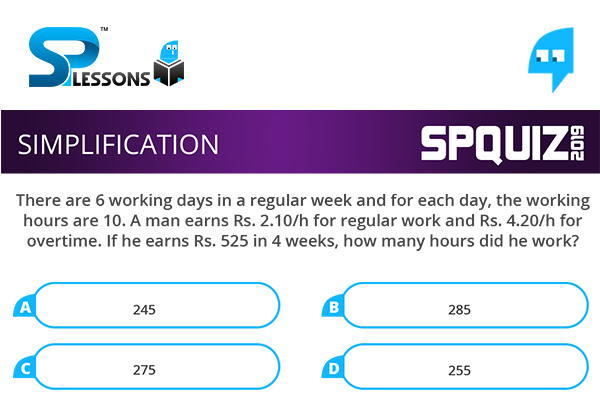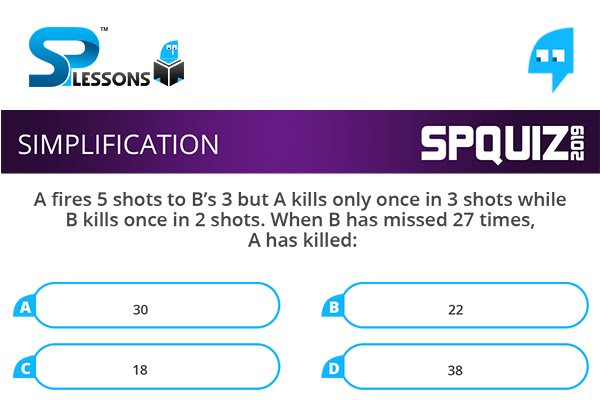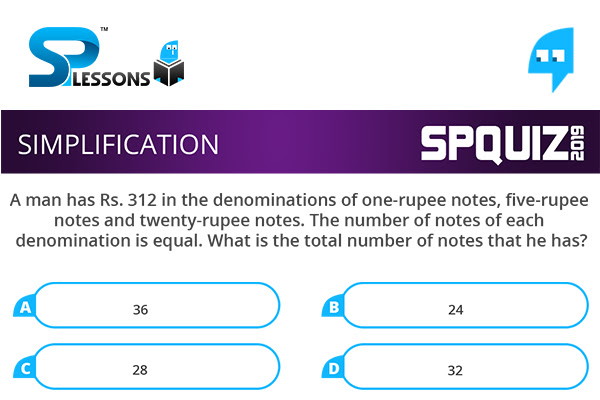 Introduction
Introduction
What is Quantitative Aptitude test?
Quantitative Aptitude is one of the prominent competitive aptitude subjects which evaluates numerical ability and problem solving skills of candidates. This test forms the major part of a number of important entrance and recruitment exams for different fields. The Quantitative Aptitude section primarily has questions related to the Simplification, Numbering Series, and Compound Interest, etc.
What is Simplification?
Simplification is the most widely asked topic in almost every competitive exam. Simplification is based on basic math calculations and some other algebraic topics. Simplification is less time consuming and having higher accuracy.
Simplification Problems is based on BODMAS rule, where
- B → Brackets,
O → Of,
D → Division,
M → Multiplication,
A → Addition, and
S → Subtraction.
 Q1
Q1
The price of 80 apples is equal to that of 120 oranges. The price of 60 apples and 75 oranges together is Rs. 1320. The total price of 25 apples and 40 oranges is
- A. 660
B. 620
C. 820
D. 780
80 apples ≡ 120 oranges
⇒ 2 apples ≡3 oranges
⇒60 apples ≡90 oranges
60 apples +75 oranges =1320
⇒ 90 oranges + 75 oranges = 1320
⇒ 165 oranges =1320
⇒1 orange = 8
1 apple = [latex] \frac {3 \times 8}{2} [/latex] = 12
25 apples + 40 oranges
= 25 × 12 + 40 × 8 = 620
 Q2
Q2
The price of 3 tables and 4 chairs is Rs. 3300. With the same money one can buy 2 tables and 10 chairs. If one wants to buy 1 table and 1 chair, how much does he need to pay?
- A. 940
B. 1050
C. 1040
D. 950
3 tables + 4 chairs ≡ 2 tables + 10 chairs
⇒1 table ≡ 6 chairs
3 tables + 4 chairs =3300
⇒ 3(6 chairs) + 4 chairs =3300
⇒ 22 chairs =3300
⇒ 1 chair =150
1 table +1 chair
≡ 6 chairs + 1 chair
=7 chairs = 7 × 150 = 1050
 Q3
Q3
There are 6 working days in a regular week and for each day, the working hours are 10. A man earns Rs. 2.10/h for regular work and Rs. 4.20/h for overtime. If he earns Rs. 525 in 4 weeks, how many hours did he work?
- A. 245
B. 285
C. 275
D. 255
Regular working hours in 44 weeks
= 4 × 6 × 10 = 240 hours
Amount earned by working in these regular working hours
= 240 × 2.10 = Rs. 504
Additional amount earned
= 525 − 504 = Rs. 21
Hours he worked overtime
= [latex]\frac {21}{4.2}= \frac {210}{42}=5[/latex]hours
Total hours he worked
= 240 + 5 = 245 hours
 Q4
Q4
A fires 5 shots to B's 3 but A kills only once in 3 shots while B kills once in 2 shots. When B has missed 27 times, A has killed:
- A. 30
B. 22
C. 18
D. 38
B missed 27 times. Hence, B fired 27 × 2 = 54 shots.
Therefore, number of shots fired by A
= [latex] \frac {54}{3} × 5 = 90 [/latex]
Therefore, number of birds killed by A
= [latex] 90 \times \frac {1}{3 }= 30 [/latex]
 Q5
Q5
A man has Rs. 312 in the denominations of one-rupee notes, five-rupee notes and twenty-rupee notes. The number of notes of each denomination is equal. What is the total number of notes that he has?
- A. 36
B. 24
C. 28
D. 32
Let number of notes of each denomination =x. Then
x + 5x + 20x = 312
⇒ 26x = 312
⇒ x = [latex]\frac { 312}{26}= 12[/latex]
Total number of notes = 3x = 3 × 12 = 36








